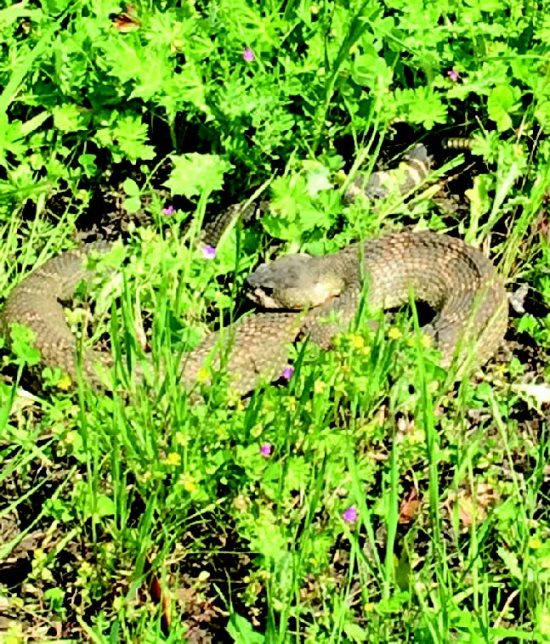| | Published May 17th, 2017
| Goodness, gracious, snakes alive!
| | | By Cathy Dausman |  | | A rattler seen in Bollinger. Photo provided |
Spring's arrival means longer, warmer and drier days - perfect for a hike in the Lamorinda hills. Enjoy the flowers and wildlife but give Crotalus oreganus, or the western rattlesnake, a wide berth.
 "Steer clear," counsels Lesa Johnston, marketing specialist for the California Department of Fish & Wildlife.
"Steer clear," counsels Lesa Johnston, marketing specialist for the California Department of Fish & Wildlife.
 Rattlesnakes are found throughout California and known to defend aggressively after presenting a series of warnings: rattling their tail, coiling their body and pre-strike posturing. "March was a busy month for rattlesnake encounters," Johnston said, citing data from the California Poison Control System.
Rattlesnakes are found throughout California and known to defend aggressively after presenting a series of warnings: rattling their tail, coiling their body and pre-strike posturing. "March was a busy month for rattlesnake encounters," Johnston said, citing data from the California Poison Control System.
 Lamorindan Ginny Hair didn't need those statistics when she came across a "big healthy guy" rattlesnake on a hike last month. "We were in Moraga at the end of Bollinger Canyon," Hair said. Neither Hair nor her hiking companion were harmed, but they managed to take pictures.
Lamorindan Ginny Hair didn't need those statistics when she came across a "big healthy guy" rattlesnake on a hike last month. "We were in Moraga at the end of Bollinger Canyon," Hair said. Neither Hair nor her hiking companion were harmed, but they managed to take pictures.
 Some suggest that this year's drastic change in weather is responsible for an increase in the rattlesnake population. "I doubt it," says wildlife biologist Mike Cardwell. He admits that while this has been "an extraordinary winter" with "an abundant crop" of rattlesnakes it is too short a time to confirm a change. Baby rattlesnakes aren't born until August or September (the youngsters are pencil-sized), so they are pretty hard to find in spring. The rattlesnakes Cardwell has radio-tracked along the American River Parkway have been reproducing "like gangbusters" over the last four years, even amid drought conditions.
Some suggest that this year's drastic change in weather is responsible for an increase in the rattlesnake population. "I doubt it," says wildlife biologist Mike Cardwell. He admits that while this has been "an extraordinary winter" with "an abundant crop" of rattlesnakes it is too short a time to confirm a change. Baby rattlesnakes aren't born until August or September (the youngsters are pencil-sized), so they are pretty hard to find in spring. The rattlesnakes Cardwell has radio-tracked along the American River Parkway have been reproducing "like gangbusters" over the last four years, even amid drought conditions.
 Cardwell says rattlesnakes produce only one brood per year and most females in his study have already been reproducing annually before this wet year. "They can't do better than that."
Cardwell says rattlesnakes produce only one brood per year and most females in his study have already been reproducing annually before this wet year. "They can't do better than that."
 It's not just rattlesnakes that are thriving post-drought - there's been enough rain for lush vegetation, which feeds the insect population, which feeds lizards and rodents and ultimately the snakes. It is the food chain which is thriving, and "I suspect this (rattlesnake growth) is pretty stable," Cardwell says.
It's not just rattlesnakes that are thriving post-drought - there's been enough rain for lush vegetation, which feeds the insect population, which feeds lizards and rodents and ultimately the snakes. It is the food chain which is thriving, and "I suspect this (rattlesnake growth) is pretty stable," Cardwell says.
 Lamorinda Weekly reporter Pippa Fisher recalls at least two local snake encounters she's had. Fisher and her dog ran past a rattlesnake two years ago while jogging the Briones Hills Loop Trail. "He didn't strike me, and my momentum carried me right past him," Fisher said, "but when I stopped and looked back he had reared up." She called to her collie mix dog, who was off leash and behind her.
Lamorinda Weekly reporter Pippa Fisher recalls at least two local snake encounters she's had. Fisher and her dog ran past a rattlesnake two years ago while jogging the Briones Hills Loop Trail. "He didn't strike me, and my momentum carried me right past him," Fisher said, "but when I stopped and looked back he had reared up." She called to her collie mix dog, who was off leash and behind her.
 Fortunately, he promptly obeyed and never spotted the snake. When her parents spotted a snake hiking in a similar area several years before that, her mother put an end to those hillside hikes, Fisher said. Because snakes are "so well camouflaged" Fisher says you must consider that every "stick" along the trail could be a snake. "They're kind of neat to see," she said, "but I did recoil."
Fortunately, he promptly obeyed and never spotted the snake. When her parents spotted a snake hiking in a similar area several years before that, her mother put an end to those hillside hikes, Fisher said. Because snakes are "so well camouflaged" Fisher says you must consider that every "stick" along the trail could be a snake. "They're kind of neat to see," she said, "but I did recoil."
 The CPCS website says rattlesnake season begins in spring and most bites occur between April and October. A rattlesnake bite can produce painful swelling, bruising, tissue destruction, bleeding problems and in rare cases can be fatal. More than 300 cases are reported to CPCS annually in California.
The CPCS website says rattlesnake season begins in spring and most bites occur between April and October. A rattlesnake bite can produce painful swelling, bruising, tissue destruction, bleeding problems and in rare cases can be fatal. More than 300 cases are reported to CPCS annually in California.
 The CPCS's assistant medical director Cyrus Rangan says online that it is important to seek medical attention immediately if bitten. Do not apply ice or use a tourniquet or try to suck out the venom or slice the bite site. Do keep calm, do not run and keep the affected extremity elevated during transport to a medical facility.
The CPCS's assistant medical director Cyrus Rangan says online that it is important to seek medical attention immediately if bitten. Do not apply ice or use a tourniquet or try to suck out the venom or slice the bite site. Do keep calm, do not run and keep the affected extremity elevated during transport to a medical facility.
 Veterinarian Mona Miller says the same strategy applies if cats or dogs get bitten. She warns that not all general veterinarian practices stock antivenin because it is "very, very, very expensive." Most rattlesnake bites affecting dogs or cats require more than 10 hours of care, she said. Miller suggests calling your regular vet practice for guidance; they'll tell you whether to head to a vet hospital. Next call that hospital to insure they have antivenin in stock. If a human has suffered the bite,"paramedics will generally bandage, transport the patient to the emergency room, and provide pain management if needed, says Moraga-Orinda Fire District Battalion Chief Jerry Lee, but "paramedics in the State of California do not provide any type of 'anti-venom' for snakebites," he said.
Veterinarian Mona Miller says the same strategy applies if cats or dogs get bitten. She warns that not all general veterinarian practices stock antivenin because it is "very, very, very expensive." Most rattlesnake bites affecting dogs or cats require more than 10 hours of care, she said. Miller suggests calling your regular vet practice for guidance; they'll tell you whether to head to a vet hospital. Next call that hospital to insure they have antivenin in stock. If a human has suffered the bite,"paramedics will generally bandage, transport the patient to the emergency room, and provide pain management if needed, says Moraga-Orinda Fire District Battalion Chief Jerry Lee, but "paramedics in the State of California do not provide any type of 'anti-venom' for snakebites," he said.
 Still, that shouldn't keep hikers from the area's beautiful trails.
Still, that shouldn't keep hikers from the area's beautiful trails.
 "I've been with MOFD for over 13 years, and only recall one incident involving a snakebite," Lee said.
"I've been with MOFD for over 13 years, and only recall one incident involving a snakebite," Lee said.
 Snakebite prevention for humans:
Snakebite prevention for humans:
 � Wear boots and long pants when hiking.
� Wear boots and long pants when hiking.
 � Stay on trails, away from underbrush and tall weeds.
� Stay on trails, away from underbrush and tall weeds.
 � Do not touch or disturb a snake, even if it appears dead.
� Do not touch or disturb a snake, even if it appears dead.
 � Carefully inspect logs or rocks before sitting on them.
� Carefully inspect logs or rocks before sitting on them.
 � Never hike alone in remote areas. Always have someone with you who can assist in an emergency.
� Never hike alone in remote areas. Always have someone with you who can assist in an emergency.
 � Teach children to respect snakes and to leave them alone.
� Teach children to respect snakes and to leave them alone.

 Snakebite prevention for pets:
Snakebite prevention for pets:
 � Carry a cell phone with vet numbers pre-programmed.
� Carry a cell phone with vet numbers pre-programmed.
 � Know the location of the nearest vet emergency hospital
� Know the location of the nearest vet emergency hospital
 � Have a harness or towel to drag a large pet to the car if the pet cannot walk.
� Have a harness or towel to drag a large pet to the car if the pet cannot walk.
 � Remove the pet's collar to mitigate swelling
� Remove the pet's collar to mitigate swelling
 Online information:
Online information:
 www.calpoison.org/about/docs/2016-03-10_CPCS_Rattlesnake_release_2016.pdf
www.calpoison.org/about/docs/2016-03-10_CPCS_Rattlesnake_release_2016.pdf
 https://nrm.dfg.ca.gov/FileHandler.ashx?DocumentID=2804&inline=1)
https://nrm.dfg.ca.gov/FileHandler.ashx?DocumentID=2804&inline=1)
 www.eyncrattlesnakes.com
www.eyncrattlesnakes.com
 www.lamorindaweekly.com/archive/issue0202/RATTLESNAKESSSSS.html
www.lamorindaweekly.com/archive/issue0202/RATTLESNAKESSSSS.html


|
| | | | | | | | | | | | |




